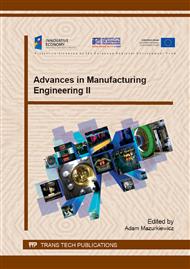p.3
p.9
p.15
p.21
p.27
p.34
p.41
p.47
Nanomultilayer Coatings Based on Vanadium Nitride
Abstract:
Based on the analysis of the research directions in the field of coatings and layers with special operating properties, the production technologies of composite coatings, including the gradient, multi-layer, and multi-component coatings, should be distinct. The paper presents the results of material properties tests of a multi-layer coating Ti / TiN / TiAlNgradient / (TiAlN/VN)multinano obtained on hot working steel EN X32CrMoV3.3. The preparation of the multilayer coating was specially designed to increase the durability of forging dies in the brass forging process. The authors discuss the results of the microstructure tests for the obtained coatings (STEM+FIB) and present the hardness and Young's modulus as a function of the distance from the surface (nanoHardness Tester CSM) and the results of adhesion tests carried out using a scratch-test method. The obtained multilayer coatings were also subject to a tribological test using a tribometer tester by DUCOM. The authors indicate that the coatings based on vanadium nitride have very high hardness and Young's modulus (HV = 32–35 GPa, E = 420–450 GPa), a much lower coefficient of friction in combination with brass than steel, and a lower stability of these parameters at elevated temperatures. According to the authors, the coating represents an interesting material solution to increase the durability of forging dies in the process of brass forging.
Info:
Periodical:
Pages:
15-20
Citation:
Online since:
August 2015
Keywords:
Price:
Сopyright:
© 2015 Trans Tech Publications Ltd. All Rights Reserved
Share:
Citation:


